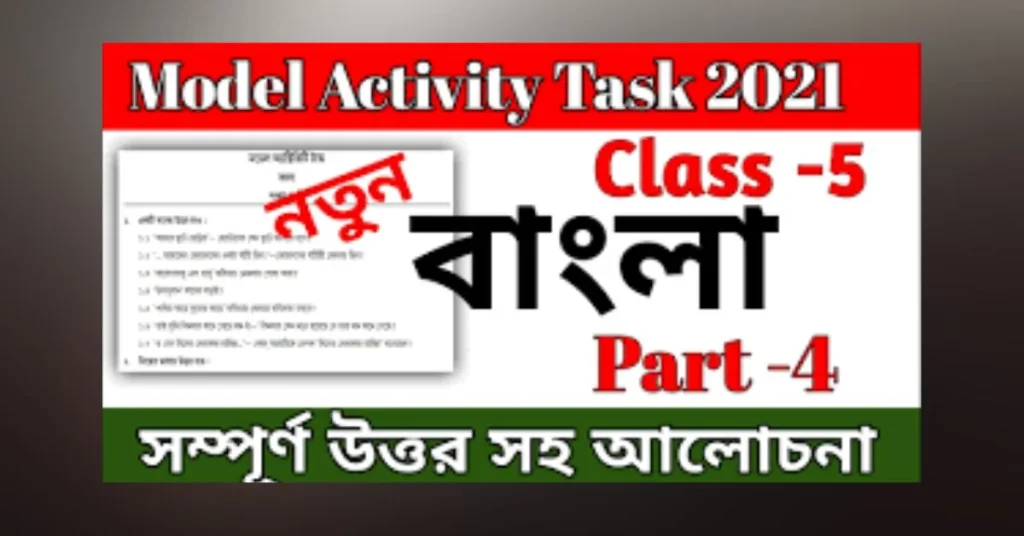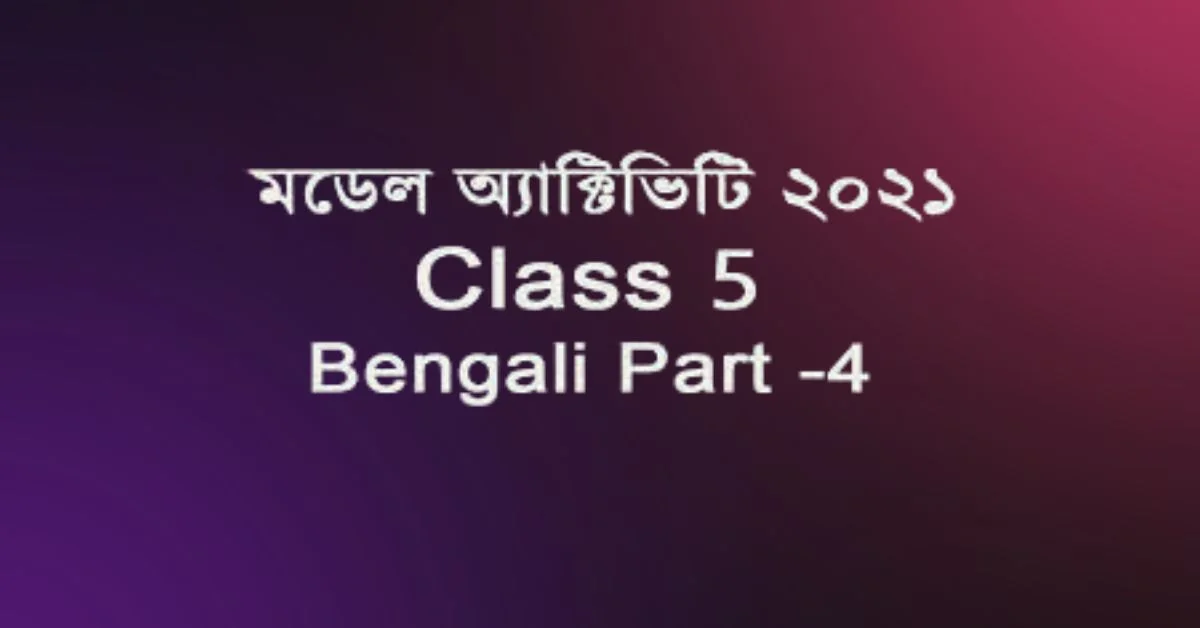If you’re looking for clear, updated, and insightful guidance on the Model Activity Task Class 5 Bengali, you’ve arrived at the right place. Whether you’re a parent trying to assist your child, a teacher preparing assignments, or a student aiming to do your best, understanding the format, purpose, and approach of these tasks is crucial. The Model Activity Task Class 5 Bengali, introduced by the West Bengal School Education Department, was designed to support continuous learning—especially during disruptions like the pandemic—and continues to evolve in 2025 with new objectives and formats that blend traditional learning with modern engagement.
In this deep-dive article, you’ll discover everything from the purpose behind the Model Activity Tasks to how they are structured, evaluated, and integrated into the Class 5 Bengali curriculum. We’ve also included teaching strategies, tips for students, and an analysis of what makes these tasks effective for foundational language development.
Why Model Activity Tasks Still Matter in 2025
Originally born out of necessity during the COVID-19 school closures, Model Activity Tasks (MATs) have grown into a core learning and assessment tool across West Bengal. Today, these tasks are no longer just backup exercises—they are essential components of formative assessment, designed to encourage creativity, comprehension, and contextual language learning in young students.
For Class 5 Bengali students, MATs serve multiple purposes:
- Reinforcing classroom lessons
- Evaluating reading and writing proficiency
- Cultivating storytelling and expressive skills
- Introducing cultural and moral elements through stories and poems
- Encouraging autonomous thinking beyond textbooks
Structure of Class 5 Bengali Model Activity Task
The Model Activity Task Class 5 Bengali typically consists of three or four activities grouped under reading, writing, and comprehension. As per the 2025 updates, tasks now focus on thematic integration, where literature, grammar, and creativity are blended under a single theme.
Key Components:
- Reading Comprehension
A short passage—either a folk tale, poem, or real-life description—is provided, followed by:- MCQs
- Short answer questions
- Vocabulary-related exercises
- Creative Writing
Prompts can include:- Story completion
- Descriptive writing
- Paragraph writing based on a given picture
- Grammar and Usage
Exercises may test:- Proper use of tense
- Gender and number agreement
- Sentence transformation
- Oral and Listening Elements (introduced in pilot mode in 2025)
Some districts are experimenting with audio-based activities for at-home listening, accompanied by worksheets.
Sample Model Activity Task Class 5 Bengali (2025 Pattern)
Let’s explore a fictional yet realistic example for this year’s Class 5 Bengali MAT.
Part 1: Reading Comprehension
Passage:
“ছোট্ট মৌমাছিটি প্রতিদিন ফুলে ফুলে উড়ে বেড়ায়। সে মধু সংগ্রহ করে এবং মৌচাকে জমা রাখে। তার পরিশ্রমে অন্য মৌমাছিরাও উৎসাহ পায়।”
Questions:
- মৌমাছিটি প্রতিদিন কোথায় যায়? (MCQ)
a) দোকানে
b) ফুলে ফুলে
c) নদীতে
d) মাঠে - মৌমাছি কী সংগ্রহ করে?
- মৌমাছিটির কাজ থেকে আমরা কী শিখি?
Part 2: Vocabulary Exercise
- ‘পরিশ্রম’ শব্দটির বিপরীত শব্দ লিখো।
- ‘উৎসাহ’ শব্দটির অর্থ লেখো।
Part 3: Writing Task
Prompt: “তোমার প্রিয় ঋতু নিয়ে একটি অনুচ্ছেদ লেখো।”
(Write a paragraph about your favorite season, describing why you like it and how you spend your time in it.)
Part 4: Grammar
- নিচের বাক্যগুলিকে লিঙ্গ পরিবর্তন করো:
- ছেলে মাঠে খেলছে।
- শিক্ষক পড়াচ্ছেন।

Pedagogical Objectives Behind the Tasks
Unlike traditional rote-learning assessments, MATs aim to promote application-based learning. According to recent curriculum guidelines by the School Education Department:
- Active Reading: Comprehension questions test more than memory. They assess whether students can infer, visualize, and evaluate.
- Personal Expression: Students are encouraged to articulate personal opinions and creative ideas through open-ended prompts.
- Language Skills Integration: Tasks combine grammar with creative writing and reading comprehension, reinforcing language naturally.
These tasks are aligned with the National Education Policy (NEP) 2020, promoting experiential and inclusive learning at the foundational stage.
The Role of Parents and Guardians
In the context of Class 5, where students are still building their foundational skills, parental involvement is not just helpful—it’s essential. Here’s how parents can engage:
- Review instructions with children without directly providing answers.
- Encourage reading aloud to build fluency and confidence.
- Discuss everyday topics in Bengali at home to improve vocabulary.
- Let children make mistakes and self-correct, especially in writing tasks.
Tips for Teachers: Making the Most of MATs in the Classroom
- Use Peer Review: After students complete tasks, conduct a peer exchange session where they read each other’s work and offer feedback.
- Connect with Real-Life Situations: Link writing tasks with festivals, seasons, or everyday experiences.
- Visual Aids and Storyboards: Use storyboards to help students sequence stories better before writing them.
- Group Reading: For comprehension tasks, divide the passage into parts and let groups take turns reading aloud.
- Differentiate by Ability: Offer supportive worksheets for students struggling with certain skills while challenging advanced learners with extension tasks.
Evaluation Criteria in 2025: Model Activity Task Class 5 Bengali
In 2025, evaluation of Model Activity Task Class 5 Bengali is being aligned more closely with competency-based assessment. Instead of only checking for right or wrong answers, teachers are encouraged to assess:
- Clarity of thought
- Logical sequencing
- Creativity
- Grammatical accuracy
- Vocabulary range
Each MAT is typically graded on a 10-mark or 20-mark scale, depending on its length and complexity. These scores feed into the Continuous Comprehensive Evaluation (CCE) records, contributing to term-wise performance reviews.
Addressing Common Challenges Students Face
1. Incomplete Responses:
Students often write one-line answers when more elaboration is needed. Teachers should model how to write fuller answers with examples.
2. Grammar Inconsistencies:
Verb conjugation and gender agreement are tricky at this age. Visual charts in the classroom or home can help.
3. Lack of Motivation:
When MATs feel like homework rather than fun, students lose interest. Adding games, rewards, or audio-visuals can boost motivation.
4. Translation Dependency:
Students often think in English and then translate. Encourage thinking and writing directly in Bengali through immersive activities.
Inclusion of Digital Tools and Printed Booklets
In 2025, schools are adopting a hybrid approach:
- Urban schools often use PDF-based tasks sent via WhatsApp or school portals.
- Rural and semi-urban schools rely on printed booklets distributed monthly.
- Voice-recorded instructions are being introduced in pilot programs to help visually impaired students.
In addition, a mobile app for MATs is under development by the state government, aimed at self-assessment and parent guidance.
Integrating Literature and Values: Model Activity Task Class 5 Bengali
Model Activity Task Class 5 Bengali are not just language exercises—they’re moral and cultural lessons. Many passages are adapted from classic Bengali literature or folk tales. Through these stories, students learn:
- Honesty and compassion
- Teamwork
- Respect for nature
- Cultural festivals and heritage
This intersection of values and vocabulary makes MATs more than just academic—they become life lessons.
The Road Ahead: Future of MATs in West Bengal
As the education system in West Bengal becomes more student-centric and interactive, Model Activity Task Class 5 Bengali are expected to play a pivotal role. According to draft proposals, future plans may include:
- Subject-integrated tasks (e.g., combining Bengali with EVS)
- Video and audio supplements
- Adaptive difficulty based on student performance
- Parental feedback loops for each submission
These changes aim to personalize the learning experience and ensure that every child not only learns but enjoys the process.
Conclusion: Model Activity Task Class 5 Bengali
The Model Activity Task Class 5 Bengali is more than a worksheet—it’s a learning ecosystem that encourages independent thought, creativity, and a love for language. In 2025, as education adapts to new realities, these tasks help maintain academic continuity while fostering emotional and cultural depth in young learners.
For parents and teachers, the key is active engagement—helping students see these activities not as a burden, but as an opportunity to express, explore, and grow.
And for students, it’s a gentle introduction to the idea that learning Bengali is not just about grammar rules or memorized answers—it’s about connecting with one’s roots, thoughts, and world.
FAQs
1. What is the Model Activity Task Class 5 Bengali?
It is a set of structured exercises provided by the West Bengal education board to assess and enhance Bengali language skills through reading, writing, and grammar tasks.
2. How are these tasks different from regular schoolwork?
Model Activity Task Class 5 Bengali are more application-based and designed for self-paced learning. They also focus on creativity and comprehension rather than rote learning.
3. Do MATs affect final grades?
Yes. They contribute to internal assessments as part of the Continuous Comprehensive Evaluation (CCE) and can influence promotion decisions.
4. Where can I find Model Activity Task Class 5 Bengali booklets?
You can obtain them from your school, local education offices, or school-specific WhatsApp groups. Some are also distributed via PDF on the education department’s website.
5. Can parents help students with their tasks?
Yes, but only in a guiding role. Encourage your child to attempt the work independently while offering help in reading instructions or reviewing answers.
For more information, click here.









